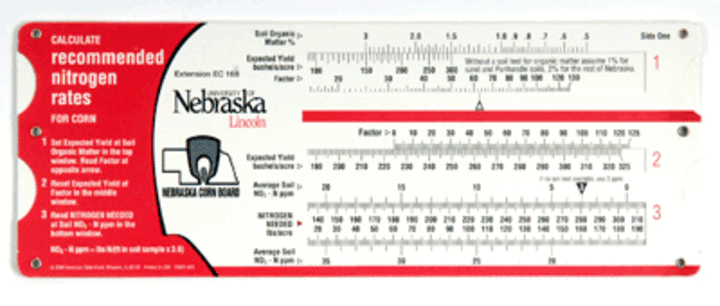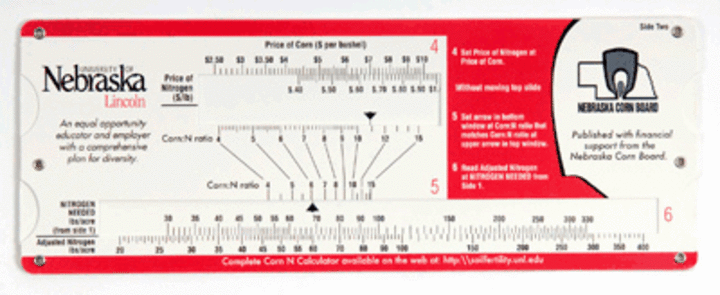March 27, 2009

|
| This Corn Nitrogen Slide Rule is available free from local Extension offices. |

|
The corn nitrogen slide rule (EC168) is free and was produced with financial support from the Nebraska Corn Board. It can be ordered:
- from local Extension offices;
- by sending a No. 10, self-addressed envelope with $0.79 postage to Charles Shapiro, 57905 866 Rd, UNL Haskell Agricultural Laboratory, Concord, NE 68728-2828; or
- from the Market Journal Web site form.
"The slide rule will help farmers know how much nitrogen is needed for corn and adjust for economic conditions," said Charles Shapiro, a UNL extension soils specialist. "It's important to apply nitrogen properly — the cost of under applying is always a lot higher than over applying."
Designed to fit in a glove box or pocket, the slide rule can be used in the field to calculate nitrogen fertilizer needs in six easy steps. To use it, farmers will need to know the amount of soil organic matter in their fields based on soil tests. (See Instructions for Using the Nitrogen Rate for Corn Slide Chart, EC 168.)
This slide rule updates an older version and includes adjustments for economic conditions. Complete recommendations and explanations for the recommendations are available in Extension Circular EC117, Fertilizer Suggestions for Corn.
"With the price of corn and nitrogen fertilizer going up and down, there are times when farmers may want to adjust their rates," he said. "This will allow them to calculate ratios between the price of corn and the price of nitrogen and then make the economic adjustment."
Computer Version
If you prefer to use your computer to calculate rates and compare costs, visit the Soil Fertility and Nutrient Management Web pages and download the Excel spreadsheet, Corn Nitrogen Recommendation Calculator. The site includes instructions and a video on using the spreadsheet and two conference papers that summarize recommendations.
The site also includes Fertilizer Chooser, a computer program that helps you compare and determine the best combination of fertilizer materials to minimize the cost of fertilization.
Sandi Alswager Karstens
IANR News Service
